Awakening 26-Year-Old Dormant Code: Is x402 a Bridge Between Web2 and Web3, a Technological Singularity or a Meme Frenzy?
 Bitget Wallet2025/11/02 00:53
Bitget Wallet2025/11/02 00:53This "reactivation" of the underlying internet protocol standards—can it become the key to bridging the gap between "convenience" and "openness"?
Can this "reactivation" of the underlying Internet protocol standard become the key to bridging the gap between "convenience" and "openness"?
Written by: Lacie, Bitget Wallet Researcher
I. Introduction: The "Payment Gap" Between Web2 and Web3
The current digital ecosystem is being torn apart by the inherent opposition between Web2 and Web3. On one hand, the convenient payments of Web2 (such as Apple Pay and WeChat Pay) are tightly locked within "walled gardens" by centralized platforms and regional boundaries; on the other hand, while Web3 promises a globally open, permissionless financial future, it has become a "technological island" that mainstream users shy away from due to its intense price volatility and complex user experience.
The chasm between "convenience" and "openness" has long saddled Web3 with the labels of "difficult to implement" and "speculative hype." Against this backdrop, an open protocol called x402 has come into the spotlight. Its solution is quite innovative: instead of reinventing the wheel, it seeks to activate a long-dormant Internet underlying standard—HTTP 402 (Payment Required), which has been asleep for 26 years.

Image: x402 official homepage introduction
Source: x402 official website (https://www.x402.org/)
Can this "reactivation" of the underlying Internet protocol standard become the key to bridging the gap mentioned above? Does it herald the imminent birth of a native, open Web payment layer, fundamentally reshaping the way value flows on the Internet? Bitget Wallet will take you through an in-depth analysis in this article.
II. A Belated Outbreak: What is x402 and Why Has It Only "Gone Viral" Now?
x402 is an open protocol developed and open-sourced by Coinbase in May 2025. Its core goal is to activate the long-unused HTTP 402 status code, transforming it into a native, permissionless Internet payment mechanism, and ultimately building a channel between Web2 applications and the Web3 value network.
However, an interesting phenomenon is that the x402 protocol was launched as early as May, but only exploded in popularity after five months of silence. In fact, the 402 status code itself is not a "new invention" of the crypto world, but a reserved code in the HTTP protocol from the 1990s.
So: why has an "old standard" and a "not-so-new" protocol sparked a flurry of market discussion only recently? The table below outlines the key milestones from the birth of x402 to its explosion in popularity, helping us understand the facts behind this "delayed outbreak."
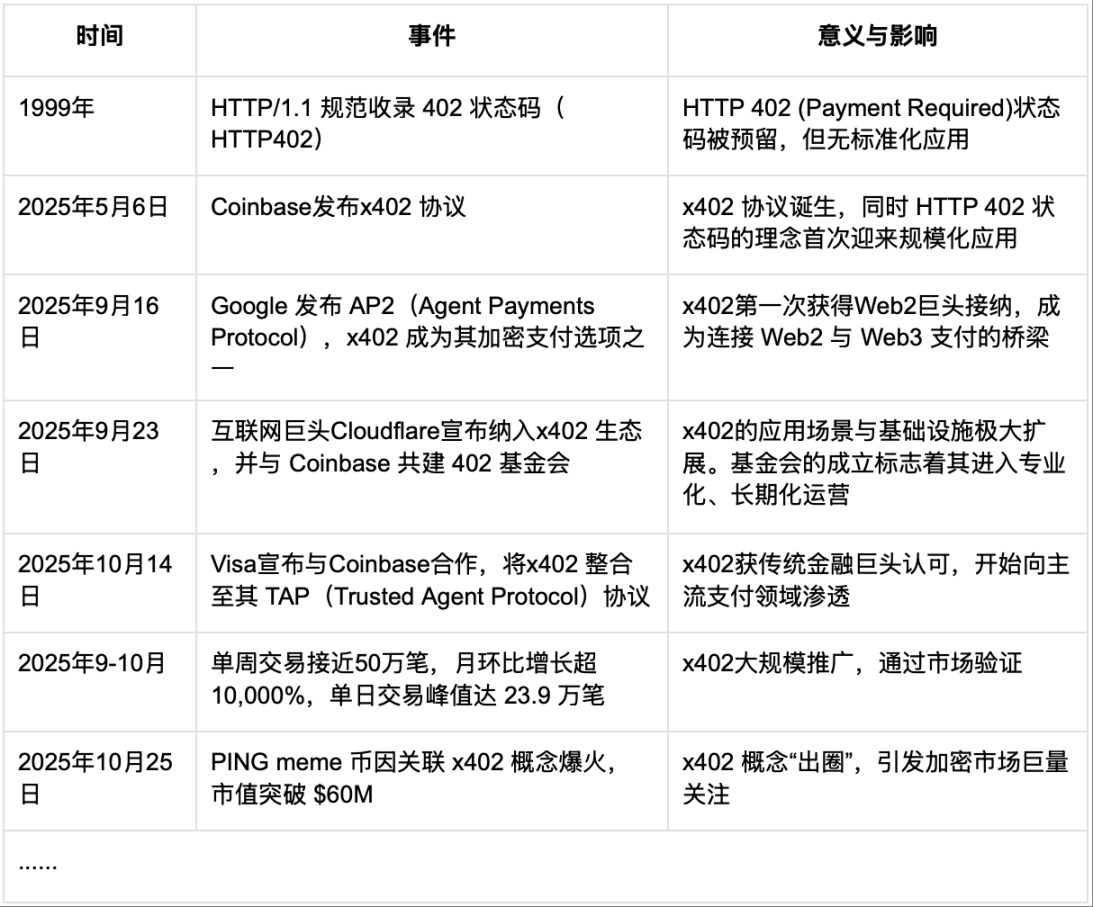
Table: Timeline of x402's Birth and Application (as of October 28, 2025)
Data source: Bitget Wallet compiled from public data (transaction data from x402scan)
As shown in the timeline above, the evolution of x402 reveals several key facts:
- First, x402 is a modern application based on the 1999 HTTP 402 status code, which was long "sealed" due to a lack of application scenarios.
- Second, the x402 protocol was initiated by Coinbase and quickly gained support and integration from Web2 giants such as Google, Cloudflare, and Visa within a few months.
- Third, although the protocol has been released for several months, what truly made it "go viral" was the recent surge of Meme coins riding on the x402 concept.
In short, the current x402 boom is the result of a combination of technological vision (AI Agent payments) and speculative frenzy (Meme-driven). But setting aside the market noise, we should focus more on its technical core—how does it actually work?
III. Unlocking and Internalizing: How Does x402 Activate the Dormant HTTP 402?
To understand x402, we must look back to the 1990s. The Internet transmits information between clients and servers via the HTTP protocol (HyperText Transfer Protocol). HTTP defines a series of response status codes (HTTP Response Status Codes) to represent specific functions, such as the well-known "404 Not Found" or "200 OK."
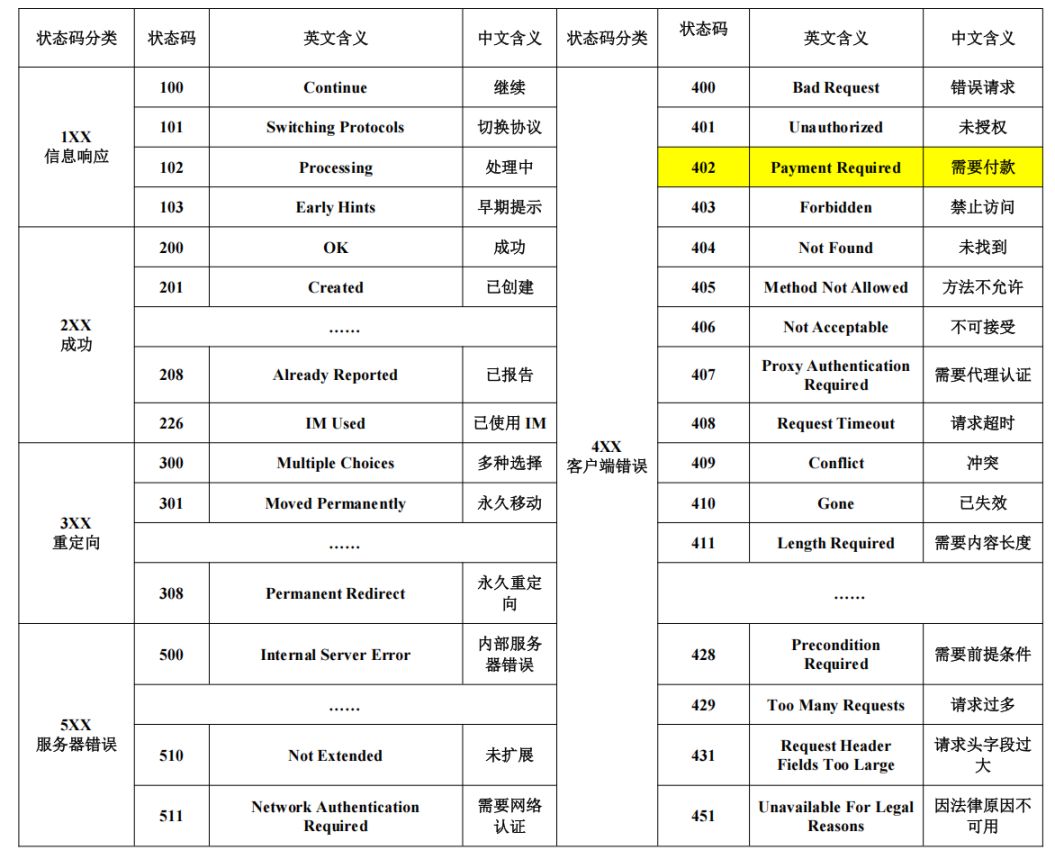
Table: Summary of HTTP Status Codes
Data source: Bitget Wallet compilation
Within this vast code system, the 402 (Payment Required) status code is particularly special. It was originally designed with a protocol-native micropayment method in mind, hoping to achieve instant payments "as seamless as loading an image"—without intermediaries or delays. But as the Internet economy shifted toward advertising, platforms, and complex credit card forms, the concept of the 402 status code was shelved, and the standard was never widely adopted.
The emergence of x402 is precisely to "unseal" the value of the 402 status code. Its workflow is logically quite ingenious:
- When a user requests a paid resource, the server no longer returns a "redirect" instruction (leading to a subscription page), but directly returns a 402 status code. This response contains all the key information needed to complete the payment: the receiving address, payment amount, supported blockchain networks (such as Base, Polygon, etc.), and currency type (such as USDC).
- Clients that support x402 (such as browser plugins or Web3 wallets), upon capturing this 402 request, automatically "translate" it into a payment prompt, and the user only needs to click to confirm. The wallet then completes the stablecoin payment via an efficient L2 network, and after the transaction is confirmed, notifies the server. The server verifies the payment and immediately unlocks the content for the user.
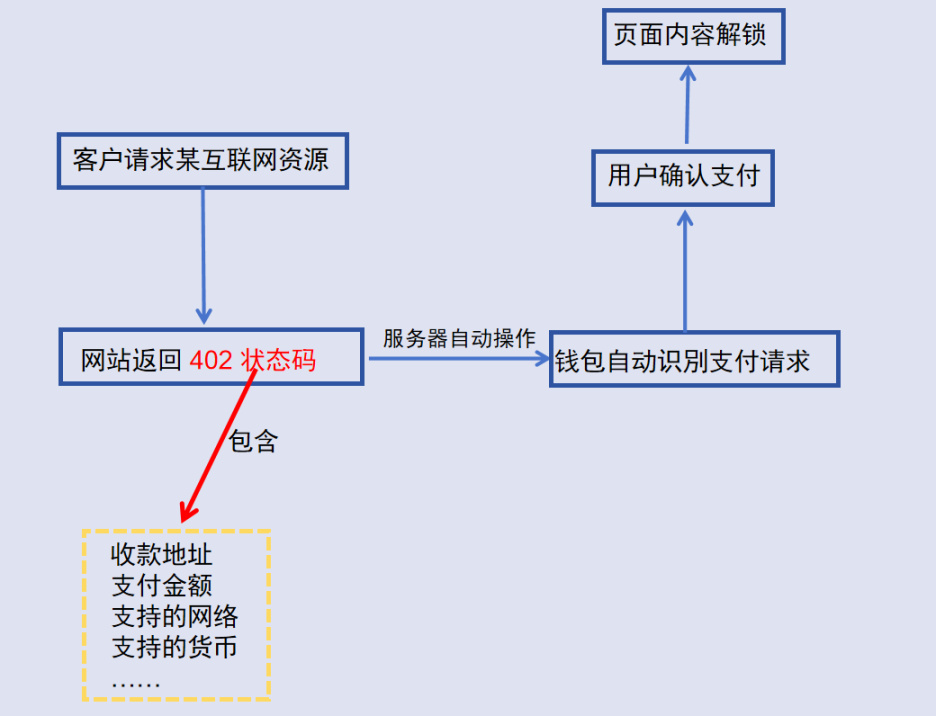
Image: x402 Workflow Diagram
Source: Bitget Wallet compilation
The entire process "internalizes" payment as part of the HTTP protocol, making it a native browser interaction just like loading an image or accessing a non-existent page. Essentially, it embeds a native "value settlement" function into the most fundamental communication layer of the Internet, truly enriching the underlying Internet transmission protocol that has existed for over 20 years at the application level.
IV. The Right Timing: Why Now?
A reasonable question is: the HTTP 402 standard has existed for 26 years, so why has it only now found an opportunity for real-world implementation through x402? The answer lies in the simultaneous presence of the "three key elements" of supply, demand, and catalyst.
First is the explosion on the demand side. The "machine economy" represented by AI Agents is rapidly emerging. AI needs to autonomously and frequently call other AI or API services and data. This machine-to-machine (M2M) automation + cross-platform micropayment is something the traditional credit card system cannot support. x402 embeds payment into HTTP requests, perfectly meeting the "granular" payment needs of API call-based billing.
Second is the technological maturity on the supply side. The infrastructure of the Web3 world is now vastly improved. The "digital cash rails" that were missing when the 402 standard was conceived have now been filled by Layer2, high-performance public chains, and widely circulated stablecoins. Their instant confirmations and ultra-low costs make native Internet micropayments economically feasible.
Finally, strong promoters are the key catalyst. Coinbase open-sourced the protocol specification, while Google and Visa endorsed it, and infrastructure giants like Cloudflare jointly launched the x402 Foundation. All these forces are working together to push x402 as a new "open Internet standard," greatly lowering the integration threshold and accelerating ecosystem formation.
It is precisely during this window of technological (supply) and demand (AI) convergence, coupled with the push from industry giants (catalyst), that x402 seized the opportunity of ready infrastructure, transforming from a dormant concept into a real-world application.
V. Singularity and Hidden Reefs: The Imagination and Triple Challenges of x402
As described in the x402 whitepaper (see image below): the most direct application of the x402 protocol is to open the door to the "machine economy" for AI Agents. In the future, AI agents will undoubtedly become the main participants of the Internet. This native, programmable payment protocol naturally fits the economic needs of M2M (machine-to-machine). It allows one AI agent to autonomously call another AI's API service and automatically pay a fee of 0.0x USD via x402, without human intervention or prepayment, greatly reducing the friction cost between services.
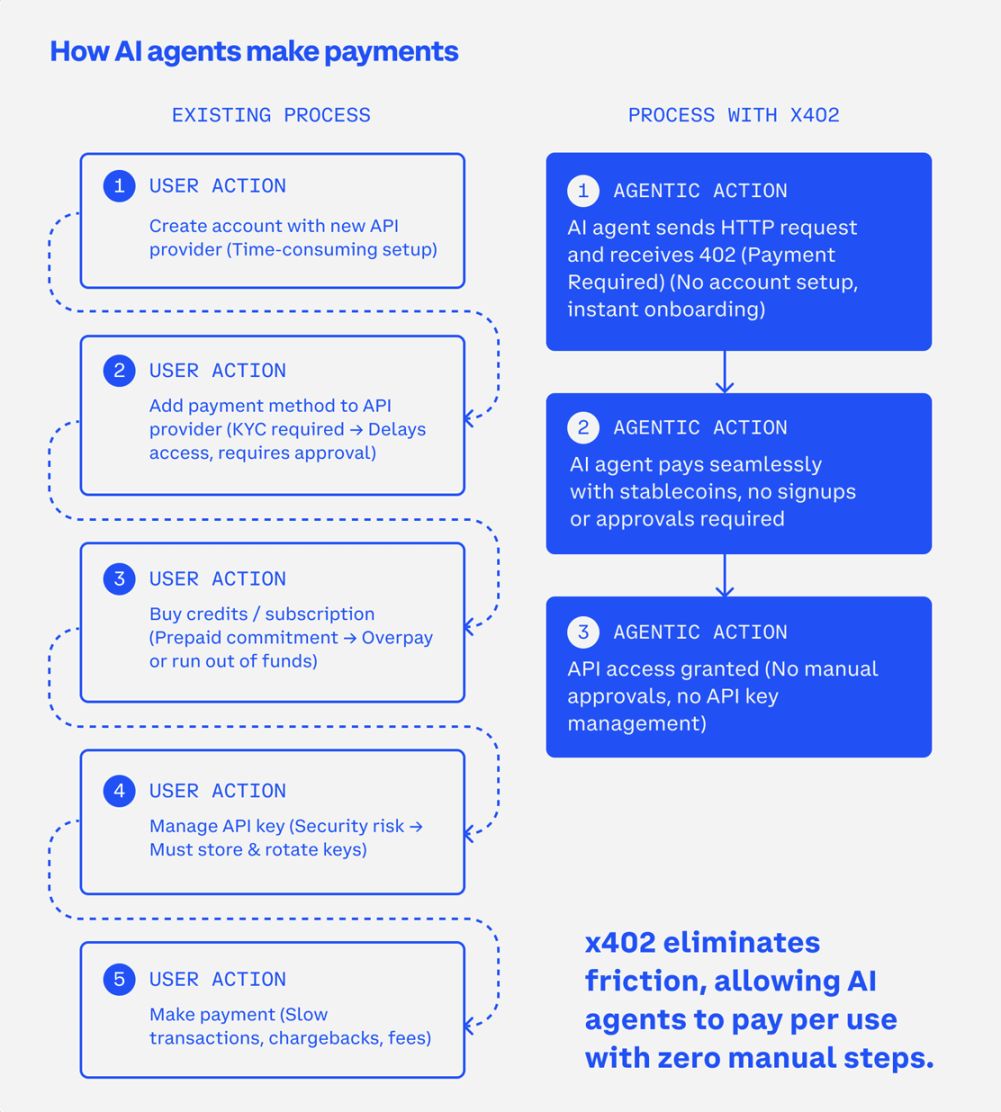
Image: Comparison of Existing Agent Payment Process and x402 Per-Call Billing
Data source: x402 Whitepaper
Its deeper significance lies in the fact that x402 enables a single HTTP request to possess both "data transmission" and "value transmission" attributes. This truly integrates the "value" dimension into the information protocol at the birth of the Internet, and at the application level, it has the potential to revolutionize the traditional WEB system that has been in use for over 20 years.
At the same time, this may answer a long-standing pain point of Web3: how can the crypto world empower the real world and change it? For a long time, the crypto world has been criticized for lacking truly mainstream applications, and x402 may well become such a singularity—it does not start from scratch, but attempts to "inject" Web3's value settlement capabilities into the vast Web2 ecosystem, becoming a true bridge connecting the two worlds—this is the underlying logic behind the protocol's widespread attention and discussion.
However, behind the optimistic vision, the challenges facing x402 should not be ignored.
First is the internal concern from the HTTP protocol itself. HTTP 402 is still a "non-standardized" reserved code. As shown in the MDN Web Docs (developer documentation library), it is defined as "reserved but undefined." This means it has not been fully accepted by mainstream Web standards and has underlying protocol compatibility issues. Therefore, the current implementation of x402 largely relies on custom HTTP headers like X-PAYMENT, rather than the true standard 402 status code, casting a shadow over its long-term standardization.

Image: HTTP 402 Status Code Highlighted for Compatibility Issues in Developer Documentation
Source: MDN Web Docs
Second, the subsequent attitudes of traditional Internet giants remain to be seen. Although giants like Google have announced their acceptance of this protocol within AI frameworks, the "bypassing platforms, peer-to-peer payments" concept advocated by x402 essentially stands in opposition to the current Internet giants who profit from "walled gardens" and payment commission models. The combination of x402 and AI Agents is more like a "declaration of war" against the traditional Internet ecosystem—whether the giants truly embrace it or are just temporarily leveraging it remains to be seen.
Finally, and most importantly, is the backlash of speculative bubbles. Since the x402 protocol itself has not issued any tokens, all tokens currently associated with it (such as PING) are experimental meme projects. While meme mania has objectively boosted x402's popularity, it also raises the question: will this movement once again fall into the false prosperity of "speculative narratives," thereby undermining the real technological vision when the bubble bursts? This is a dilemma the crypto world has always struggled to escape. (The image below shows the x402 ecosystem map)
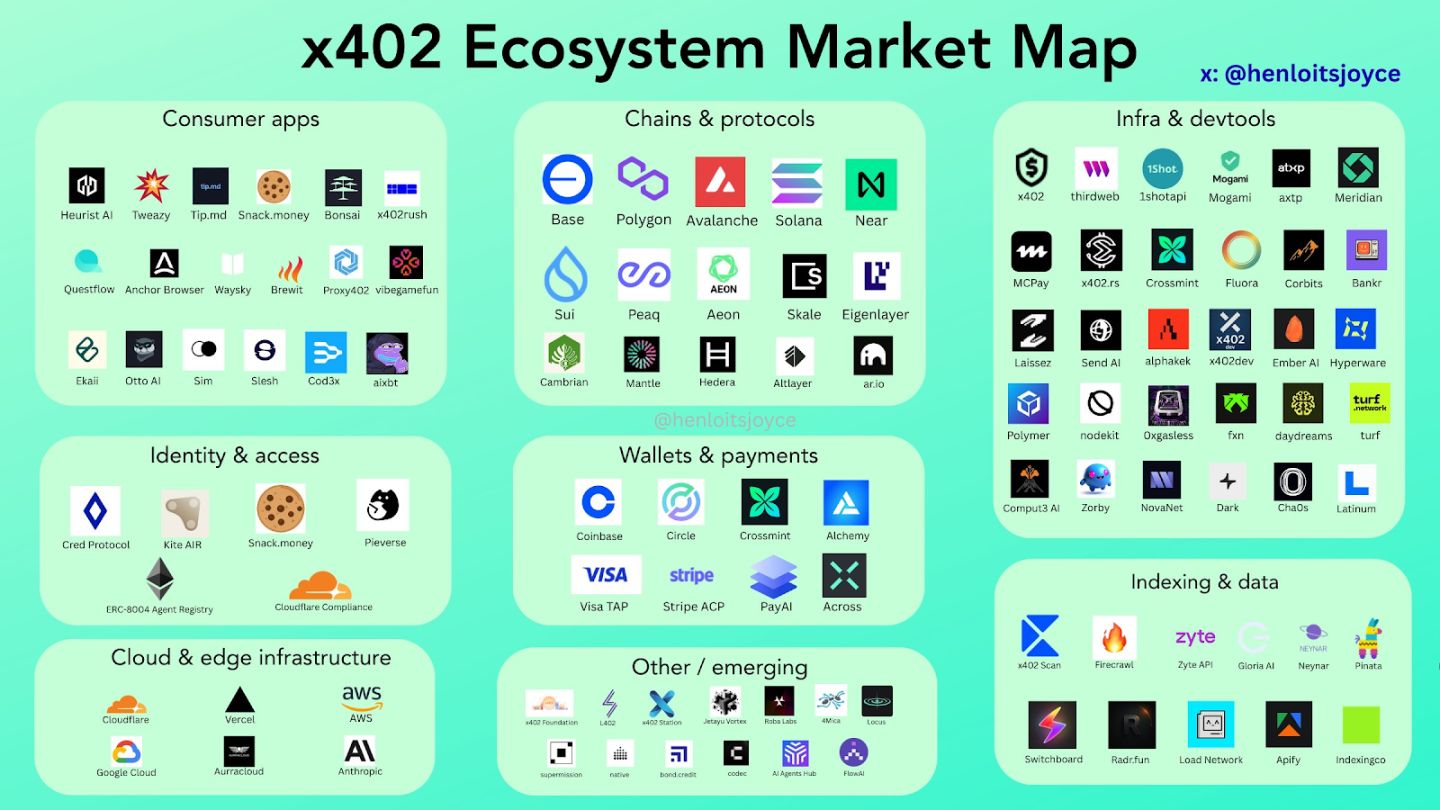
Image: x402 Ecosystem Overview
Source: X @henloitsjoyce
VI. Conclusion: Above the Noise, What is the Value?
x402 provides an extremely pragmatic solution for AI Agent payments—it does not require users to abandon the existing Internet, but attempts to complete the key upgrade of "payment" at the most fundamental protocol level. Looking back at the entire development process of x402, it is rather ironic that what truly made x402 "go viral" was not its ingenious technical design, but the speculative frenzy of Meme coins in late October. This means that many of the current analyses of x402's disruptive potential are "seeing the bubble first, then backtracking the meaning."
The current x402 boom is driven more by speculative narratives than by technological breakthroughs. This raises a core question: is x402 a milestone in the integration of Web3 and Web2, a true singularity propelling the Internet into the "value layer"? Or is it merely a lifeline that the crypto market has accidentally grabbed while searching for the next "100x narrative"?
The answer still awaits the test of time. But in any case, the concept of a "native HTTP value layer" pointed out by x402 has already provided a profound direction for Web3 to empower Web2. This reflection on the future form is far more valuable than the current market noise.
Disclaimer: The content of this article solely reflects the author's opinion and does not represent the platform in any capacity. This article is not intended to serve as a reference for making investment decisions.
You may also like
Altcoin Market Dominance Hits 6-Year Base Support and Rebounds Strongly

SUI Price Holds at $2.44 as Market Consolidates Between $2.42 Support and $2.58 Resistance

Filecoin Regains Momentum: Break Above $2.30 May Open Path Toward $4.60 Trendline

SHIB Holds at $0.00000998 as Price Consolidates Between Key Support and Resistance
